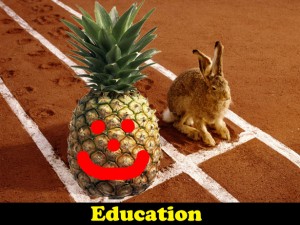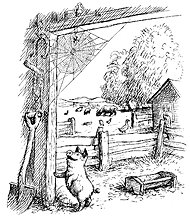
File this under: You can’t make this stuff up.
Below are links to the flap about a story that appeared on a standardized English test in New York State. The entire controversy should remind us that literary texts in general do not lend themselves to multiple-choice questions. I’m waiting for “Jabberwocky” to appear on one of these tests or any passage from Alice’s Adventures in Wonderland, but especially the passage in which the king ponders the difference between “important” and “unimportant” or Humpty-Dumpty decides that a word can mean anything he wants it to mean. I was fascinated by the observation reported below:
Deborah Meier, founder of the progressive Central Park East schools in New York City, who has lectured and written widely about testing, said the pineapple passage was “an outrageous example of what’s true of most of the items on any test, it’s just blown up larger.” In the world of testing, she said, it does not really matter whether an answer is right or wrong; the “right” answer is the one that field testing has shown to be the consensus answer of the “smart” kids. “It’s a psychometric concept,” she said.
Below the story as reported by NPR:
A reading passage included this week in one of New York’s standardized English tests has become the talk of the eighth grade, with students walking around saying, “Pineapples don’t have sleeves,” as if it were the code for admission to a secret society.
The passage is a parody of the tortoise and the hare story, the Aesop’s fable that almost every child learns in elementary school. Only instead of a tortoise, the hare races a talking pineapple, and the moral of the story — more on that later — is the part about the sleeves.
While taking the test, baffled children raised their hands to say things like, “This story doesn’t make sense.”
Antitesting activists have taken up the cudgel, saying that the passage and the multiple-choice questions associated with it perfectly illustrate the absurdity of standardized testing. And by Friday afternoon, the state education commissioner had decided that the questions would not count in students’ official scores.
Daniel Pinkwater, a popular children’s book author who wrote the original version of the passage, which was doctored for the test, said that the test-makers had turned a nonsensical story into a nonsensical question for what he believed was a nonsensical test, but acknowledged that he was tickled to death by the children’s reaction.
In the olden times, animals could speak English, just like you and me. There was a lovely enchanted forest that flourished with a bunch of these magical animals. One day, a hare was relaxing by a tree. All of a sudden, he noticed a pineapple sitting near him.
The hare, being magical and all, told the pineapple, “Um, hi.” The pineapple could speak English too.
“I challenge you to a race! Whoever makes it across the forest and back first wins a ninja! And a lifetime’s supply of toothpaste!” The hare looked at the pineapple strangely, but agreed to the race.
The next day, the competition was coming into play. All the animals in the forest (but not the pineapples, for pineapples are immobile) arranged a finish/start line in between two trees. The coyote placed the pineapple in front of the starting line, and the hare was on his way.
Everyone on the sidelines was bustling about and chatting about the obvious prediction that the hare was going to claim the victory (and the ninja and the toothpaste). Suddenly, the crow had a revolutionary realization.
“AAAAIEEH! Friends! I have an idea to share! The pineapple has not challenged our good companion, the hare, to just a simple race! Surely the pineapple must know that he CANNOT MOVE! He obviously has a trick up his sleeve!” exclaimed the crow.
The moose spoke up.
“Pineapples don’t have sleeves.”
“You fool! You know what I mean! I think that the pineapple knows we’re cheering for the hare, so he is planning to pull a trick on us, so we look foolish when he wins! Let’s sink the pineapple’s intentions, and let’s cheer for the stupid fruit!” the crow passionately proclaimed. The other animals cheered, and started chanting, “FOIL THE PLAN! FOIL THE PLAN! FOIL THE PLAN!”
A few minutes later, the hare arrived. He got into place next to the pineapple, who sat there contently. The monkey blew the tree-bark whistle, and the race began! The hare took off, sprinting through the forest, and the pineapple …
It sat there.
The animals glanced at each other blankly, and then started to realize how dumb they were. The pineapple did not have a trick up its sleeve. It wanted an honest race — but it knew it couldn’t walk (let alone run)!
About a few hours later, the hare came into sight again. It flew right across the finish line, still as fast as it was when it first took off. The hare had won, but the pineapple still sat at his starting point, and had not even budged.
The animals ate the pineapple.
http://www.npr.org/blogs/thetwo-way/2012/04/20/151044647/the-pineapple-and-the-hare-can-you-answer-two-bizarre-state-exam-questions
https://www.nytimes.com/2012/04/21/nyregion/standardized-testing-is-blamed-for-question-about-a-sleeveless-pineapple.html
http://www.nytimes.com/interactive/2012/04/20/nyregion/21pineapple-document.html?ref=nyregion






